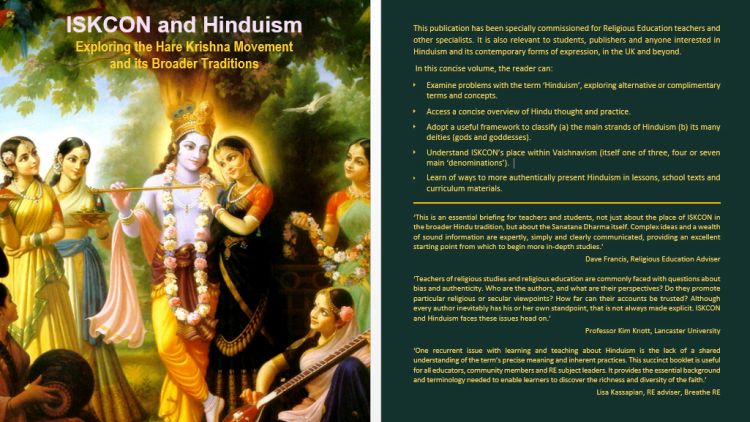New Educational Booklet Explores ISKCON and Hinduism
By Madhava Smullen | Мар 21, 2020

A newly-published booklet, entitled “ISKCON and Hinduism: Exploring the Hare Krishna Movement and its Broader Traditions,” will be used to help students and teachers in schools, as well as visitors to ISKCON temples, better understand ISKCON and how it relates to broader Hinduism. (During the COVID-19 pandemic, it will be available to order by mail)
The 26-page illustrated booklet is published by ISKCON Educational Services, (IES) which was established at Bhaktivedanta Manor over thirty years ago and arranges for about twelve thousand school students, teachers, parents and governors to visit the temple per year.
During the visits children often take a cart ride to see the cows at the goshala; dress up in saris and turbans; do face painting; and listen to a presentation on both broader Hinduism and ISKCON’s own Vaishnava tradition. IES staff also make presentations at schools, and have departments in London and Newcastle as well.
It’s all part of the UK’s Religious Education curriculum, in which primary and secondary students learn about the nation’s six main religious traditions – Christianity, Islam, Judaism, Sikhism, Hinduism and Buddhism.
The booklet “ISKCON and Hinduism” came about as a response to questions from teachers during IES presentations. “Teachers have been asking, ‘What is the difference between what you do in ISKCON and Hinduism, as practiced by the wider Hindu community?’” says IES General Manager Tulsi-seva Dasi.
ISKCON Educational Services also felt a booklet on the similarities and differences would be important after seeing a bullet point in the Hinduism A-Level studies syllabus that mentioned ISKCON as “a divergence from ‘traditional’ Hinduism.”
The booklet is written by Rasamandala Das, who established IES with his brother Indriyesh, has an MA in Religious Education from Warwick University, and is the author of The Illustrated Encyclopedia of Hinduism, Hinduism: Faith and Practices, and other works.
“ISKCON and Hinduism” covers a range of topics including Defining Hinduism; Hindu Philosophy; Hindu Practices and Way of Life; Denominations within Hinduism; Hinduism as a Global Religion; ISKCON and Hinduism; Distinctive Views and Practices[of ISKCON]; A History of ISKCON; ISKCON Worldwide; Engaging with the World; Teaching about Hindu Traditions; and Addressing Misconceptions.
In “Defining Hinduism,” Rasamandala discusses the history of the term, explaining, “Persians of the 8th century first used the term ‘Hindu’ to refer to the people beyond the River Indus. Only in the 19th century did European scholars coin the term ‘Hinduism’. They tried to understand and explain the indigenous Indian traditions through their own values and conceptual frameworks. Drawing from their own faith backgrounds, they defined Indian religion as a single, cohesive faith, which they designated ‘Hinduism.’”

Rasamandala Das, author of the booklet
He then outlines views on the history of Hinduism, how Hindus often prefer alternative names such as Santana-dharma (the eternal religion), and how Hindus define themselves.
“Hindus also struggle to appropriately name and define their traditions; what is it, if anything, that binds them together, or lends them unity?” the booklet reads. “Followers define not just what Hinduism is, but what they think it should be. There are many opinions.
“Contemporary scholars have identified two main trends. First, attempts to preserve and perpetuate traditions by linking Hinduism to the Indian nation, to its people and its governance. Second, propounding the inclusive (but possibly vague) idea of universal truth, open to all, irrespective of country, race and so on. Although Hinduism is closely linked to India—its people, history and many holy sites—precise definition remains elusive. Fluidity and diversity are themselves distinctive features of Hinduism.”
In “Hindu Philosophy,” the booklet explains the Vedanta school of thought; key concepts of the eternal self, karma, reincarnation, and liberation; Hindu ideas of God, including the non-personal and the personal; features of God such as Brahman, Antaryami (or Paramatma) and Bhagavan; and Hindu Ethics.
It also explains the four principal paths of yoga: action (karma), knowledge (jnana), meditation (astanga) and devotion (bhakti); the four varnas (propensities for a type of work): shudra (worker), vaishya (business person), kshatriya (administrator) and brahmana (priest and scholar); and the four ashramas (stages of life): brahmacharya (student life), grihastha (household life), vanaprashtha (retired life) and sannyasa (renounced life).
In “Denominations within Hinduism,” the booklet explains Vaishnavism, Shavism, and Shaktism. And in Hinduism as a Global Religion, it talks about how Hindu migrants have settled in many countries and spread Hinduism worldwide.
In the section on “ISKCON and Hinduism,” Rasamandala Das explains the relationship between the two. “The term ‘Hinduism’ was first coined by the British in the 19th century,” he writes. “Some ISKCON devotees reject the term to avoid defining their religion in ways they consider exclusive or sectarian, or constrained by concepts and categories specific to the Western world. They often prefer the alternative name ‘Sanatana-dharma’ (‘eternal truth’ or ‘eternal law’).”
He adds: “Dharma means ‘that which sustains us according to our real nature.’ It implies an intrinsic spirituality rather than a faith that is temporary, adopted, or external to our true selves. ISKCON’s founder, A. C. Bhaktivedanta Swami, used the term Santana-dharma. He also favoured Varnashrama-dharma. However, following in the footsteps of Chaitanya, who lived five centuries earlier, he criticized the hereditary caste system.
“As ISKCON has sought greater participation from the broader Hindu community, it has increasingly used the term ‘Hinduism.’ Still, many members express disquiet with it. Some suggest the term should be abandoned, while others advocate qualifying its use, in a way that stresses the non-sectarian core of the tradition. Some prefer the phrase ‘Vedic tradition,’ but its exact meaning is disputed. It is clear, however, that when describing Hinduism, one needs to consider alternative terms.”

Tulsi-seva Dasi, General Manager at ISKCON Educational Services
The booklet also covers ISKCON’s distinctive views and practices, such as following Chaitanya Vaishnavism; worshipping Radha and Krishna and Chaitanya Mahaprabhu; chanting the Hare Krishna maha-mantra; aiming to use everything in Krishna’s service (yukta-vairagya), and focusing on specific texts like Bhagavad-gita, Srimad-Bhagavatam and Sri Chaitanya-caritamrita.
It explains that ISKCON devotees view God as personal, and consider the goal of life to be Krishna-prema (love of God), above even moksha (liberation), which is considered the highest by most Hindus.
The booklet looks at staple inner practices of ISKCON members, such as study of the scriptures, japa meditation, and temple worship; as well as their distinctive missionary spirit with outreach activities like book distribution, prasadam distribution, and public chanting (Harinama-Sankirtana).
Rasamandala also describes the history of ISKCON, from Chaitanya Mahaprabhu, the six Goswami and Bhaktivinode Thakur, to Srila Prabhupada establishing the International Society for Krishna Consciousness in the Western World in 1966.
Finally, he gives readers a look at ISKCON worldwide today – its temples, farms, restaurants, eco-projects and educational institutions – and how it engages with the world on interfaith, moral and social issues, environmental projects, and education. The booklet also includes a section on misleading stereotypes and correcting misconceptions.
“The purpose of the booklet is to educate, and to make people aware that the Hindu tradition cannot be defined from just one point of view, because there are so many other traditions under the umbrella of Hinduism,” Tulsi-seva says. “I think teachers have trouble teaching about Hinduism, because there are too many different traditions. So hopefully this makes it simpler for them to understand, and to teach to their students.”
Before the COVID-19 pandemic began, ISKCON Educational Services planned to distribute “ISKCON and Hinduism: Exploring the Hare Krishna Movement and its Broader Traditions” to teachers who came to visit the Manor with their schools, and to temples worldwide for visitors.
IES also planned to distribute it amongst other educational faith and non-faith groups, via its membership of the Religious Education Council for England and Wales; and to schools via local SACREs (Standing Advisory Councils on Religious Education), of which it’s also a faith member.
With all schools in the UK, as well as many temples around the world now closed, widespread use of the booklet will be delayed, although IES can still mail copies to those who want to use them in our new world of social distanced learning.
“Everything is in Krishna’s hands,” says Tulsi-seva. “We’ve got to be patient.”
To order copies of the booklet, please email the IES office at ies@krishnatemple.com. It will be also available for purchase on Bhaktivedanta Manor’s online shop at https://krishnashopping.com/
ISKCON Educational Services is also appy to assist any temple who would like to implement their programme of school visits in their region.















